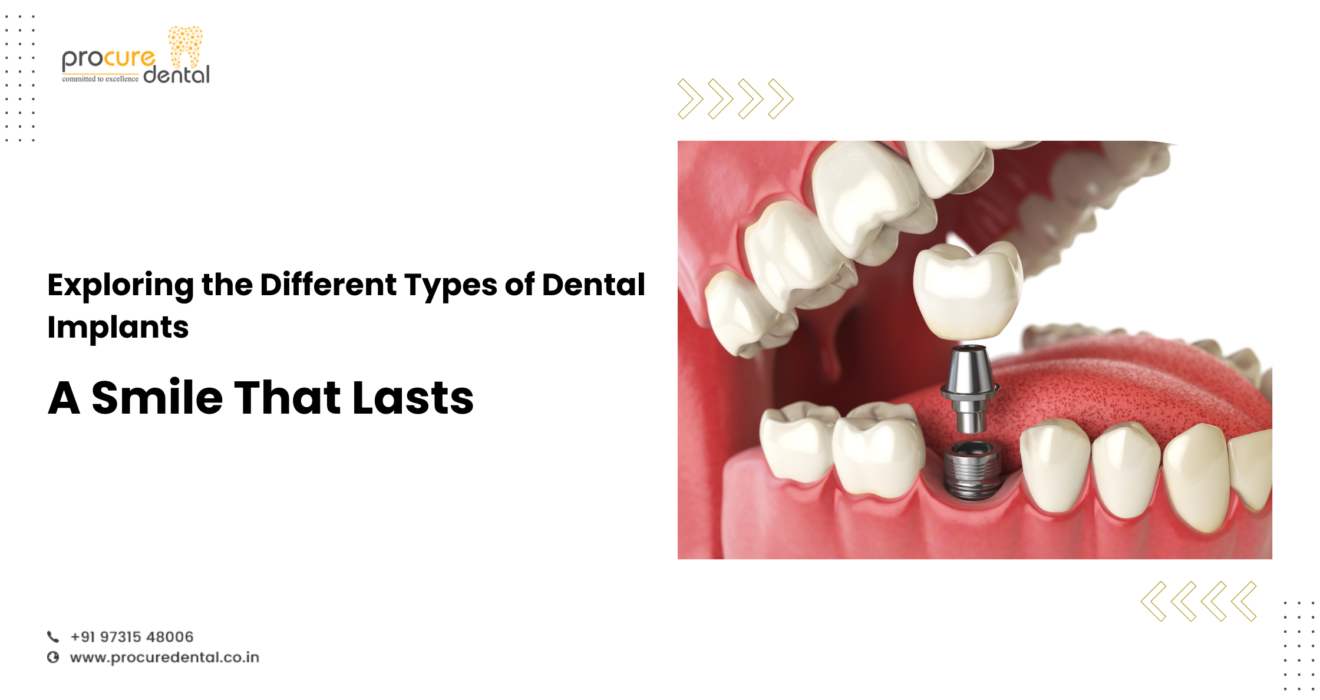Exploring the Different Types of Dental Implants: A Smile That Lasts
Losing a tooth can feel like a big deal, but thanks to modern dentistry, it doesn’t have to be the end of your smile’s story. Dental implants have revolutionized tooth replacement, offering a permanent solution that looks, feels, and functions like a natural tooth. But did you know there are different types of dental implants? That’s right—whether you need to replace a single tooth, multiple teeth, or even an entire set, there’s an implant option tailored to your needs. Let’s dive into the different types of dental implants and how they can restore your smile.
What Are Dental Implants?
Before we get into the types, let’s cover the basics. A dental implant is a small titanium post that is surgically placed into the jawbone, where it acts as a replacement for the root of a missing tooth. Once the implant integrates with the bone (a process called osseointegration), a crown, bridge, or denture can be attached to it, providing a stable and secure tooth replacement.
The Main Types of Dental Implants
There are three main types of dental implants, each suited to different situations. Here’s a closer look at each:
1. Endosteal Implants: The Most Common Choice
What Are They?
Endosteal implants are the most commonly used type of dental implant. They are typically shaped like small screws and are placed directly into the jawbone.
Best For:
- Patients with a healthy, dense jawbone that can support the implant.
- Those looking to replace one or multiple teeth.
Procedure:
After the implant is placed in the jawbone, it takes several months to heal and integrate with the bone. Once healing is complete, an abutment (a small connector) is attached to the implant, and then a crown, bridge, or denture is placed on top.
Pros:
- High success rate.
- Feels and functions like a natural tooth.
- Can last a lifetime with proper care.
Cons:
- Requires sufficient jawbone density.
- Involves a longer healing process.
2. Subperiosteal Implants: For Those With Less Bone Density
What Are They?
Subperiosteal implants are placed under the gum but on or above the jawbone, rather than into it. This type of implant is used for patients who don’t have enough healthy jawbone and cannot (or prefer not to) undergo a bone graft.
Best For:
- Patients with insufficient bone height in the jaw.
- Those who want a less invasive option.
Procedure:
A metal framework is placed under the gum, and posts are attached to the frame. The gums heal around the frame, securing it in place. Then, just like with endosteal implants, artificial teeth are attached to the posts.
Pros:
- Doesn’t require as much bone density.
- Shorter healing time compared to endosteal implants.
Cons:
- Less stable than endosteal implants.
- Typically used less often.
3. Zygomatic Implants: The Solution for Severe Bone Loss
What Are They?
Zygomatic implants are the least common type of dental implant and are used in cases of severe bone loss in the upper jaw. Instead of being placed in the jawbone, these implants are anchored in the cheekbone (zygomatic bone).
Best For:
- Patients with severe bone loss in the upper jaw.
- Those who are not candidates for bone grafting.
Procedure:
Zygomatic implants involve a more complex surgical procedure, where the implant is placed into the cheekbone. Due to the complexity, not all dental surgeons perform this procedure.
Pros:
- Provides a solution for patients with significant bone loss.
- Eliminates the need for bone grafting.
Cons:
- More invasive and complex procedure.
- Longer healing time and higher risk of complications.
Additional Implant Options: Tailored Solutions for Unique Needs
In addition to the main types of implants, there are other specialized implant solutions designed for specific situations:
All-on-4 Implants: Full Arch Restoration in One Day
- What Is It? A method that uses four implants to support an entire arch of teeth (upper or lower). The implants are placed at strategic angles to maximize stability.
- Best For: Patients who need a full arch of teeth replaced and want a quick, effective solution.
- Pros: Can often be completed in a single day, with fewer implants required. Provides a full, stable set of teeth.
- Cons: Requires sufficient bone for implant placement. If bone density is low, additional procedures may be necessary.
Mini Implants: Small But Mighty
- What Are They? Mini implants are smaller in diameter than traditional implants and are often used for patients with less bone density or space.
- Best For: Patients who need smaller implants due to bone limitations or those requiring stabilization for lower dentures.
- Pros: Less invasive and can often be placed in one visit. Faster healing time.
- Cons: Not as strong or long-lasting as traditional implants. May not be suitable for all tooth replacement needs.
How to Choose the Right Type of Dental Implant
Choosing the right type of dental implant depends on several factors, including the condition of your jawbone, your overall health, and your specific dental needs. Here are a few things to consider:
- Bone Density: Your dentist will assess the density and health of your jawbone to determine which implant type is best suited for you. If you lack sufficient bone, you may need a bone graft or might consider subperiosteal or zygomatic implants.
- Number of Teeth to Replace: If you need to replace a single tooth, an endosteal implant is likely the best choice. For multiple teeth or a full arch, All-on-4 or other specialized implant systems may be recommended.
- Health and Lifestyle: Your overall health, including factors like smoking, diabetes, and gum disease, can affect the success of dental implants. Your dentist will discuss these factors with you to determine the best course of action.
- Budget and Time: Dental implants are an investment, and the costs and timeline can vary depending on the type of implant and additional procedures required. Your dentist can help you weigh the options based on your budget and schedule.
Final Thoughts: A Brighter Future for Your Smile
Dental implants are a fantastic option for anyone looking to restore their smile after tooth loss. With so many different types of implants available, there’s a solution for nearly every dental situation. Whether you need a single tooth replaced or a full set, implants offer a long-lasting, natural-looking solution that can boost your confidence and improve your oral health.
So, if you’re considering dental implants, take the time to explore your options and consult with your dentist to find the best fit for your smile. Here’s to a future of happy, healthy, and beautiful teeth!



